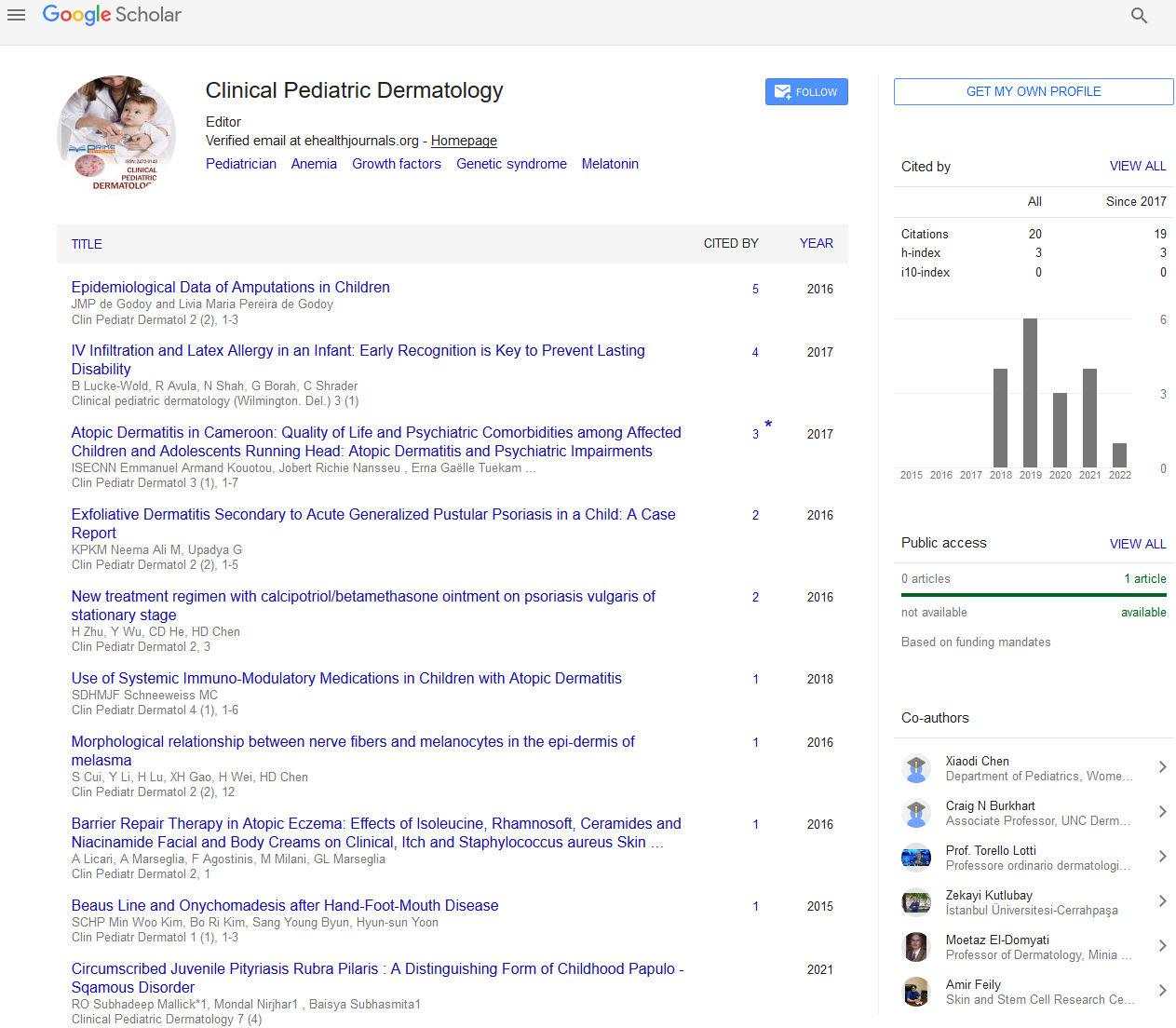Short Communication - (2024) Volume 10, Issue 4
Current Advances in the Diagnosis and Management of Atopic Dermatitis in Children
Amy Paller*
Department of Biomedical Science, Northwestern University, USA
*Correspondence:
Amy Paller,
Department of Biomedical Science, Northwestern University,
USA,
Email:
Received: 03-Dec-2024, Manuscript No. ipcpdr-24-22246 ;
Editor assigned: 05-Dec-2024, Pre QC No. ipcpdr-24-22246 (PQ);
Reviewed: 19-Dec-2024, QC No. ipcpdr-24-22246 ;
Revised: 24-Dec-2024, Manuscript No. ipcpdr-24-22246 (R);
Published:
31-Dec-2024, DOI: 10.36648/2472-0143.10.4.31
Introduction
Pediatric dermatology is a crucial subspecialty focusing on
diagnosing and managing skin conditions in children. Unlike adults,
children often present unique dermatologic challenges, given
their developing immune systems and distinctive skin physiology.
Common conditions encountered in pediatric dermatology
include atopic dermatitis, which remains one of the most
prevalent disorders, particularly in infancy and early childhood.
Children with eczema frequently suffer from intense pruritus, skin
xerosis, and erythematous patches, which, if untreated, can lead
to secondary bacterial infections such as impetigo. These bacterial
infections, often caused by Staphylococcus aureus, present as nonbullous
impetigo with honey colored crusting or bullous impetigo
characterized by fragile vesicles. Another condition that often
coexists with eczema is keratosis pilaris, which manifests as rough,
follicular papules on the upper arms, thighs, or cheeks [1,2].
Description
Infectious dermatoses are a significant subset of pediatric skin
disorders. Viral conditions like molluscum contagiosum and
warts are commonly observed. Molluscum contagious presents
as dome-shaped, umbilicated pules caused by a poxvirus,
while verruca vulgaris, or warts, are attributed to human
papillomavirus. Children frequently contract these conditions
through direct contact or contaminated objects. Tinea infections,
or dermatophytoses, are fungal infections commonly seen on the
scalp or body. These infections often present as annular lesions
with central clearing and peripheral scaling, requiring antifungal
therapy. Scabies and pediculosis capitis remain additional common
parasitic infestations in pediatric patients, leading to significant
pruritus and discomfort. Another group of skin conditions that
pediatric dermatologists frequently manage are viral exanthems,
which include measles, rubella, and erythema infectiosum. These
viral rashes are often associated with systemic symptoms such
as fever, cough, and malaise, presenting as maculopapular or
vesicular eruptions. Kawasaki disease is a critical condition that
also involves the skin, presenting with polymorphous exanthema,
erythema of the lips, strawberry tongue, and desquamation of the
palms and soles. This condition requires prompt recognition and
treatment with intravenous immunoglobulin to prevent coronary
artery complications. Among pigmentation disorders, vitiligo is a
notable concern, characterized by depigmented macules resulting
from melanocyte destruction. Conversely, conditions like café au
lait spots, frequently associated with neurofibromatosis, present
as hyper pigmented macules that may require evaluation for
underlying systemic involvement. Epidermal nevi and nevus
sebaceous are additional pigmented lesions that are congenital
and may evolve with age. Congenital hemangiomas and vascular
malformations are common cutaneous findings in neonates.
Infantile hemangiomas, which appear as bright red, raised lesions,
typically undergo rapid growth followed by slow involution. In
contrast, port-wine stains, seen in conditions like Sturge-Weber
syndrome, are capillary malformations that persist throughout
life. Pediatric autoimmune and inflammatory skin disorders are
also important to address [3-5].
Conclusion
Juvenile dermatomycosis’s, a rare inflammatory condition,
involves heliotrope rash on the eyelids, Gottron’s papules on the
knuckles, and proximal muscle weakness. Psoriasis, although
less common in children than adults, presents as erythematous
plaques with silvery scales, often triggered by infections such as
streptococcal pharyngitis. Lichen planus, another inflammatory
condition, manifests as violaceous, pruritic papules, sometimes
associated with mucosal involvement. Hair and nail disorders
are not uncommon in pediatric dermatology. Alopecia areata, an
autoimmune condition, presents as well-demarcated, non-scarring
hair loss, often in patches. Onychomycosis, or fungal infection of
the nails, can lead to nail dystrophy and discoloration, requiring prolonged antifungal therapy. Nail abnormalities may also arise in
systemic conditions like psoriasis or hypothyroidism.
Acknowledgement
None.
Conflict Of Interest
None.
References
- Butler DC (2020) Dermatology's management of flagship diseases in older adults: Lifting the blindfold. JAMA Dermatol. 156(11):1175-1176.
[Crossref] [Google Scholar]
- Daunton A (2022) Introducing athena: Clinical and experimental dermatology's article to help prepare for the UK dermatology specialty certificate examination. Clin Exp Dermatol. 47(7):1227.
[Crossref] [Google scholar]
- Muller SA (2011) Climate change, dermatology and ecosystem services; trends and trade-offs. Int J Dermatol. 50(5):504-7.
[Crossref] [Google Scholar]
- Udey MC (2020) Jumpstarting the journal of investigative dermatology's social media effort: Calling on experts. J Invest Dermatol. 140(10):1882-1883.
[Crossref] [Google Scholar]
- Kelly M (2023) Remembering dermatology's part in the history of AIDS: The 40th anniversary of the AIDS candlelight vigils. J Eur Acad Dermatol Venereol. 37(7): e898-e899.
[Crossref] [Google Scholar]
Citation: Paller A (2024) Current Advances in the Diagnosis and Management of Atopic Dermatitis in Children. Clin Pediatr Dermatol. 10:31.
Copyright: © 2024 Paller A. This is an open-access article distributed under the terms of the Creative Commons Attribution License, which permits unrestricted use, distribution, and reproduction in any medium, provided the original author and source are credited.

